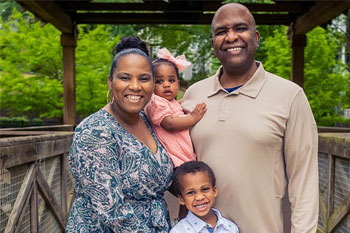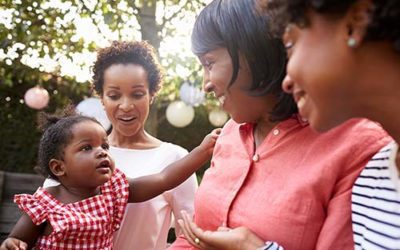 When making the decision to adopt, it is important to recognize how this decision will affect each family member. Adopting while you have a biological child (or children) already is a unique experience. Bringing a new little brother or sister home to your child will be a change for them and require some adjusting.
When making the decision to adopt, it is important to recognize how this decision will affect each family member. Adopting while you have a biological child (or children) already is a unique experience. Bringing a new little brother or sister home to your child will be a change for them and require some adjusting.
As a parent, you must prepare your children for the new family member. Since this transition is different from welcoming a biological sibling at birth, I’d like to provide you with some guidance on getting your children ready for this significant change. This process will be changing their lives, and you need to make sure they’re ready for it.
Let your children know your family is about to grow, and it may take a while for everyone to adjust to the new family dynamic. It will be a unique experience for everyone. Routines may change, the house may be noisier, or they may need to be quiet when the baby sleeps. Everyone will need to learn how to get along. You can encourage them by sharing that you are proud of them and their willingness to welcome their newly adopted sibling.
With these seven tips, you can find a healthy and meaningful way to transition into a solid and connected adoptive family.
1. Start the Conversation
The best thing you can do to help your biological child prepare for a new sibling is to talk with them. Get a conversation going about what they might expect. Encourage them to ask you questions and encourage them to be honest. There is no wrong feeling or question. You can also ask them questions, such as:
- Are you worried that our family will be different?
- Are you afraid of anything?
- What do you think will be the hardest thing for you?
- What do you think will be the easiest thing for you?
- How can I help you during this time?
- Talking will help your children feel reassured you are thinking of them and want to help them.
“…I found that adoptive siblings whose families talked freely and openly about their thoughts and feelings had the most cohesive families, the closest sibling relationships, and were the most satisfied in their families,” Dr. Jana Hunsley shares about her study on adoptive siblings in a piece published by the National Council for Adoption. She continues, “The number of children in the family, age differences, age at adoption, birth order changes, and amount of trauma the adopted child had experienced did not affect the way adoptive siblings viewed their families. It was all about building a home with healthy communication in which the family could talk freely, honestly, and openly about their thoughts and feelings.”
2. Share that Families All Look Different
Begin by explaining to your child that families can be different, look different, and be formed in different ways. For example, some families have just one child, while others have several children. And while some families may have all daughters, sometimes single moms raise their kids by themselves, or a family may include grandparents that live in the home.
Talk to them about how adopting means bringing a child into a family. If you’re adopting a child from outside your race, talk about skin colors. Depending on how old your child is, they may get questions from both other kids and adults. You can help them come up with an appropriate response by practicing scripts that feel comfortable to your family and allow a sense of privacy. Since kids have a way of taking pre-rehearsed lines and making them their own, a variety of options will help both of you feel confident.
3. Include Them in the Adoption Journey
As you get yourselves and your home ready for the baby you’ll adopt, include your children in the preparations. Ask them for their ideas about decorating the baby’s room. Include them on your shopping trips to buy baby clothes and toys. Let them pick out toys. Get their opinions on how to set a toy area. By involving them in the process, you’re helping your child adjust to being a big brother or sister.
4. Read Books About Adoption
Reading real-life stories about families who have adopted can be inspirational and helpful for your children. They can get excited about their new siblings as they hear about other kids who have been in their shoes. Make sure to visit Lifetime Adoption’s Recommended Reading list, which has a section of children’s books you can purchase or check out from your local library.
5. Be Realistic
Be sure not to sugarcoat the adoption of a new sibling. Adoption can be difficult at times. A new child in your home will change the dynamic; everyone in the family will have adjustments at some point.
Remind your children that they will need to share their toys (and you!) with their new little brother or sister. They may feel irritated when their new sibling cries a lot or throws things. Remind them they can always come to talk to you if they have concerns. You are in this together, and together you can work through any difficulties.
6. Be Mindful
To have a healthy and connected family, it’s important to be aware of your own emotions, triggers, and regulation strategies, and also pay attention to the mental and emotional states of your family members. What mindfulness looks like for parents is being able to tell when their child is feeling sad, angry overwhelmed, etc., and knowing what to do when their child experiences these feelings.
It’s important for parents to recognize that determining their child’s needs can be a process that takes time and effort. However, it’s vital to remember that all children have unique needs that should be met by their parents.
To have open and honest communication, you must be present with your family—attuned to your own mental and emotional state as well as those of others within the family. Failing to practice mindfulness in communication can lead to a breakdown in communication at best and result in family members feeling like they are unable to express their needs at worst. It is important to be aware of this and make a conscious effort to communicate effectively with your loved ones.
7. Get Them a “Big Brother” or “Big Sister” Gift
Welcoming a new baby into the family is a significant change for everyone, particularly for the child stepping into the role of an older sibling. To help make this transition smoother and to honor their new responsibilities, many families turn to thoughtful “big brother” or “big sister” gifts.
These gifts can range from toys that teach them how to care for babies to engaging activities* that keep them entertained and even keepsakes to cherish this memorable occasion. Here are some gift ideas you can consider giving your child, helping to spark an incredible bond with their adopted sibling:
- A new baby doll: Playing together side by side can be a simple way to ease feelings of jealousy and engage them in the activities that occupy your time. A popular option is this baby doll* from Melissa & Doug.
- Personalized sibling book: You can customize books such as Me and My Big Brother/Me and My Big Sister and A New Sibling for You with your children’s names. These sweet books will take them on everyday adventures and magically grow up with them!
- Photo frame: If you’re looking for a sentimental gift, a framed photo will commemorate your expanding family and make your older kids feel special. Check out these simple frames from Target: Me and My Sister Frame or Me and My Brother Frame.
- Superhero Cape: What a fun way to celebrate their new status as a big sibling! We love this bright “Big Brother” cape and this sweet embroidered pink cape for big sisters.
* Lifetime Adoption may earn a small commission if you purchase through these links. We only recommend products we know and trust.
Preparing Your Child for an Adopted Sibling
Adopting a child is always an adventure, but bringing home an adopted child if you already have biological kids takes planning and preparation. So, avoid assuming your child understands the process or what will happen. Talk about all the details. Give them the chance to voice their worries and concerns. Be realistic with them. There will be some tough days with the new sibling. But that’s part of being in a family. Be sure to let them know how proud you are of them for being willing to open their heart to this new little person.
In this heartwarming video, Robert and Petra bring their newly adopted daughter home to meet her new brothers!
Editor’s Note: This article was originally published on November 3, 2021, and has since been updated.
Founder of Lifetime Adoption, adoptive mom, adoption expert, and Certified Open Adoption Practitioner (C.O.A.P).
Since 1986, adoption expert Mardie Caldwell has been dedicated to bringing couples and birth parents together in order to fulfill their dreams.
“Many years ago, I was also searching for a child to adopt. We didn’t know where or how to get started. Through research, determination, and a prayer, our dream of a family became reality. I started with a plan, a notebook, assistance from a caring adoption consultant and a lot of hard work; this was my family I was building. We had a few heartaches along the way, but the pain of not having children was worse!
Within weeks we had three different birth mothers choose us. We were overwhelmed and delighted. Many unsettling events would take place before our adoption would be finalized, many months later. Little did I know that God was training and aligning me for the adoption work I now do today. It is my goal to share with our families the methods and plans which succeed and do not succeed. I believe adoption should be affordable and can be a wonderful “pregnancy” for the adoptive couple.
I have also been on both sides of infertility with the loss of seven pregnancies and then conceiving by new technology, giving birth to a healthy daughter. I have experienced first-hand the emotional pain of infertility and believe my experience allows me to serve your needs better.
It is my hope that for you, the prospective parents, your desire for a child will be fulfilled soon.”





0 Comments